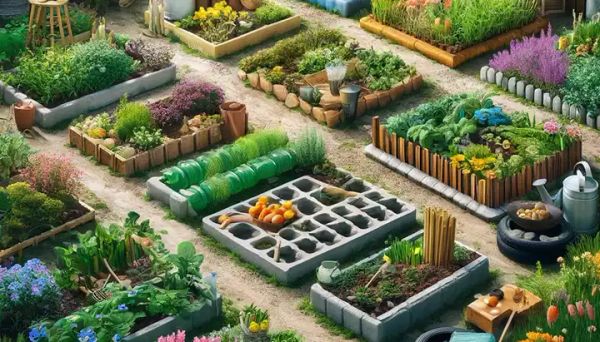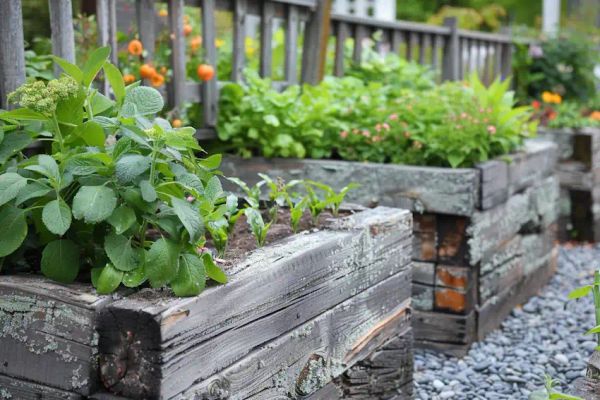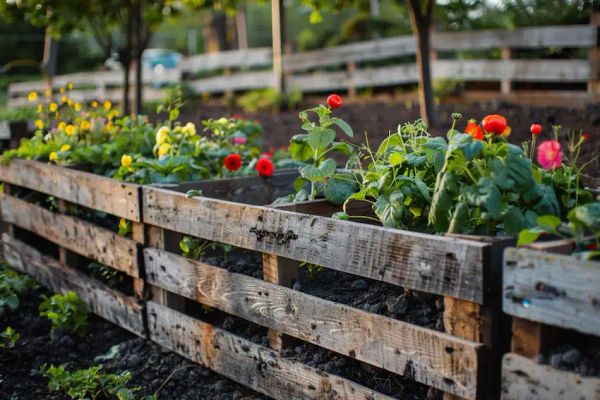
Creating borders around your garden beds has more benefits than just adding beauty to your outdoor space. It helps keep pests away, maintain the shape of the beds, and prevent soil erosion. If you want to fence your garden beds without spending a fortune, here are some creative and affordable ideas using everyday materials.
1. Cement Blocks

Using cement blocks is a durable and versatile option for garden bed borders. You can arrange them in various ways to create a neat and sturdy fence. Here’s how you can use them:
Materials Needed:
- Cement blocks
- Soil
- Plants
Steps:
- Dig a shallow trench around your garden bed.
- Place the cement blocks in the trench, side by side.
- Fill the blocks with soil and plant small flowers or herbs in them for added beauty.
- Ensure the blocks are level and stable.
Benefits:
- Long-lasting and durable.
- Can be painted or decorated to match your garden theme.
- Provides extra planting space.
2. Plastic Bottles
Recycling plastic bottles into a garden bed border is an eco-friendly and cost-effective way to add a unique touch to your garden.
Materials Needed:
- Plastic bottles (same size)
- Soil
- Paint (optional)
Steps:
- Clean and dry the plastic bottles.
- Fill the bottles with soil or sand for stability.
- Bury the bottles neck-down around the perimeter of the garden bed.
- Optionally, paint the bottles for a colorful border.
Benefits:
- Reduces plastic waste.
- Easy to replace and rearrange.
- Adds a colorful and creative look.
3. Wooden Pallets

Repurposing wooden pallets is a great way to create a rustic and charming fence for your garden beds.
Materials Needed:
- Wooden pallets
- Nails
- Hammer
- Saw
Steps:
- Disassemble the pallets into individual planks.
- Cut the planks to the desired height for your fence.
- Nail the planks together to form a continuous border around the garden bed.
- Sand down any rough edges to avoid splinters.
Benefits:
- Inexpensive and readily available.
- Adds a natural and rustic appearance.
- Can be painted or stained for a customized look.
4. Stone Borders
Using stones to create a border is another natural and cost-effective way to enhance your garden beds.
Materials Needed:
- Stones
- Landscape fabric
- Shovel
Steps:
- Collect stones of similar size and shape.
- Lay landscape fabric along the perimeter of the garden bed to prevent weeds.
- Place the stones on top of the fabric, ensuring they fit snugly together.
- Adjust the stones to ensure a level and stable border.
Benefits:
- Natural and attractive appearance.
- Durable and weather-resistant.
- Helps prevent weed growth around the garden bed.
5. Bamboo Stakes
Bamboo stakes provide a sustainable and aesthetically pleasing option for garden bed borders. They are lightweight yet sturdy, making them easy to work with.
Materials Needed:
- Bamboo stakes
- Garden twine
- Scissors
Steps:
- Cut the bamboo stakes to your desired height.
- Insert the stakes into the ground around the perimeter of your garden bed.
- Use garden twine to secure the stakes together, wrapping it tightly around the top and bottom of the stakes.
- Ensure the stakes are evenly spaced and stable.
Benefits:
- Eco-friendly and renewable resource.
- Adds an exotic, natural look to the garden.
- Easy to install and adjust.
6. Recycled Tires
Old tires can be repurposed into a fun and unique garden bed border. They are durable and provide a substantial barrier to keep out pests and prevent soil erosion.
Materials Needed:
- Old tires
- Utility knife
- Paint (optional)
Steps:
- Clean the tires thoroughly.
- Optionally, cut the tires in half to create a semi-circular border.
- Place the tires around the garden bed, partially burying them for stability.
- Paint the tires for a vibrant, colorful border.
Benefits:
- Reuses materials that would otherwise go to waste.
- Strong and durable border.
- Adds a whimsical and playful touch to the garden.
7. Woven Branches

Woven branch fences, also known as wattle fencing, are a traditional and charming way to border garden beds. They are perfect for a cottage garden look.
Materials Needed:
- Flexible branches (willow or hazel are ideal)
- Garden stakes
- Pruners
Steps:
- Insert garden stakes around the perimeter of the garden bed, spacing them about a foot apart.
- Weave flexible branches in and out of the stakes, starting from the bottom and working your way up.
- Continue weaving until the desired height is reached.
- Trim any excess branches for a neat finish.
Benefits:
- Uses natural materials.
- Provides a rustic, cottage garden aesthetic.
- Can be easily customized and repaired.
Fencing your garden beds doesn’t have to be expensive or complicated. With a bit of creativity and resourcefulness, you can create beautiful, functional borders using materials like cement blocks, plastic bottles, wooden pallets, stones, bamboo stakes, recycled tires, and woven branches. Each method offers unique benefits, allowing you to choose the best option for your garden’s needs and aesthetic. By repurposing everyday items, you not only save money but also contribute to sustainable gardening practices. Enjoy experimenting with these ideas and watching your garden beds flourish with well-defined, attractive borders.




